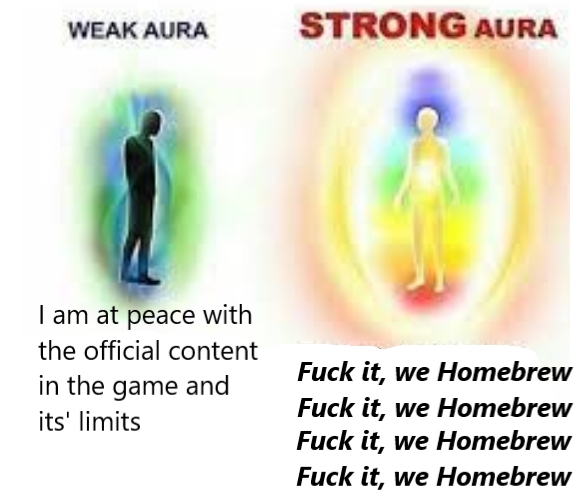this post was submitted on 21 Oct 2023
129 points (89.1% liked)
RPGMemes
10342 readers
264 users here now
Humor, jokes, memes about TTRPGs
founded 1 year ago
MODERATORS
you are viewing a single comment's thread
view the rest of the comments
view the rest of the comments

Precisely. 5e's greatest strength is its' simplicity. A player who's never touched a TTRPG before will have a much easier time picking up 5e than a more niche system (although PF2e is definitely not bad on that front, 5e is just super simple and even has resources for absolute beginners)
But that simplicity is also 5e's greatest weakness. Once you're beyond the starting phase and understand how to play, then you realize how much stuff 5e is missing, you start noticing how some of the rules are oversimplified and unclear, and you REALLY notice how the game starts to get dysfunctional at levels 13 and above due to Quadratic Wizard and the fact that AC doesn't keep up with hitrate.
But 5e at its' core is a simple, robust system that's dead easy to homebrew for. So covering that weakness (and being able to keep finding players for your games) is entirely within the realm of possibility. And hey, unlike trying to mod an actual game, if you decide that at all costs you want to play an Actual Dragon? Fuck it, we Homebrew.
I don't know what other games you've been playing, but while 5e is simple compared to other D&D editions and other big long-running systems, it's significantly more complex and harder to pick up and start playing than the vast majority of indie TTRPGs, many of which have rulebooks with under 30 pages.
Hard agree. I've played exclusively with one group, and we've only ever played with Into the Odd-style combat. It's been plenty expressive for us.
My experience with 5E hasn't been that it's all that simple, though. Bounded accuracy and advantage/disadvantage are great intro mechanics, of course, since they cut down on math at the table, but the number of poorly integrated subsystems, and rules with unaddressed edge cases just leaves things confusing, unpredictable, and unsatisfying far too frequently.
Lack of text to read isn't the same thing as simplicity.
Exactly. The one major issue with homebrew for me are magic items. The game doesn't define their power level much and it's very difficult to understand how to create them at a balanced rate.
https://docs.google.com/document/d/15je74qMiYxSEnF43zp2UkEoSk3LqRymMbxruPVGQ-i4/edit?usp=sharing
I've got you. So there are two things you need to understand.
Official magic items are probably THE worst balanced and designed thing in 5e. It's like WotC didn't really want them to be part of the game and REALLY didn't want you to be able to craft them. Official item balancing is complete trash and should be wholly ignored, including rarity tags. (Case in point: Ring of Warmth [Uncommon] is a directly better Ring of Cold Resistance [Rare], Flametongue is Rare while Frostbrand is Very Rare, Ioun Stones suck major dick, etc)
The most important thing for pricing your magic items is to ask how much a plain +1, +2, and +3 weapon costs. Those are very basic items with clearly defined power levels, and you can determine the value of other items by comparing them to those basic weapons. In my games, a +1 weapon is 500gp, a +2 weapon is 6,000gp, and a +3 weapon is 80,000gp. That means that not only can I give all my other items fair prices, but if I compare my pricing to say, OneDnD where a +1 weapon costs 800gp, then that means I know that to maintain intended balance for a OneDnD adventure I should increase all prices by 60% (One of my friends runs the OneDnD prices for their low magic world, so this trick can be really helpful).
Anyways that document there has about 200 items that I've been making whenever I'm bored, so feel free to look around and steal some stuff.
Thanks! I love finding stuff like this where people create items and price then. I'll make great use of it. My favorite thing at a first glance:
I also use this sheet someone made for official item prices that seem the most consistent to get a feel.
Not a bad list. It definitely operates on a different train of thought to mine (and mine was admittedly influenced by the bad advice regarding these items' prices in the DMG)
My principle form the DMG was that Uncommon items cost between 100 and 1,000, Rare items are between 1,000 and 10,000, and so forth.
My secondary philosophy is that every extra effect on an item costs exponentially more than the last. Mostly to prevent people from making uberweapons on the cheap.
In any case, feel free to reshuffle my prices.
Lol no. That is the last thing 5e has going for it.
D&D has traumatized a whole generation of table top players into thinking it's easier to stay with it than change to any other system that takes a session to pick up to a level that d&d takes months to. It's an abusive relationship.